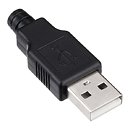- Joined
- Oct 9, 2007
- Messages
- 47,895 (7.37/day)
- Location
- Dublin, Ireland
| System Name | RBMK-1000 |
|---|---|
| Processor | AMD Ryzen 7 5700G |
| Motherboard | Gigabyte B550 AORUS Elite V2 |
| Cooling | DeepCool Gammax L240 V2 |
| Memory | 2x 16GB DDR4-3200 |
| Video Card(s) | Galax RTX 4070 Ti EX |
| Storage | Samsung 990 1TB |
| Display(s) | BenQ 1440p 60 Hz 27-inch |
| Case | Corsair Carbide 100R |
| Audio Device(s) | ASUS SupremeFX S1220A |
| Power Supply | Cooler Master MWE Gold 650W |
| Mouse | ASUS ROG Strix Impact |
| Keyboard | Gamdias Hermes E2 |
| Software | Windows 11 Pro |
USB Implementers Forum (USB-IF), the support organization for the advancement and adoption of USB technology, today announced the publication of the USB4 specification, a major update to deliver the next-generation USB architecture that complements and builds upon the existing USB 3.2 and USB 2.0 architectures. The USB4 architecture is based on the Thunderbolt protocol specification recently contributed by Intel Corporation to the USB Promoter Group. It doubles the maximum aggregate bandwidth of USB and enables multiple simultaneous data and display protocols.
The development of the USB4 specification was first announced in March 2019 by the USB Promoter Group. It is now officially published by USB-IF and available for download here.

Key characteristics of the USB4 solution include:
The upcoming USB Developer Days 2019 will include detailed technical training covering the USB4 specification and the latest for USB Type-C, USB Power Delivery, and new USB-IF branding strategies.
View at TechPowerUp Main Site
The development of the USB4 specification was first announced in March 2019 by the USB Promoter Group. It is now officially published by USB-IF and available for download here.

Key characteristics of the USB4 solution include:
- Two-lane operation using existing USB Type-C cables and up to 40 Gbps operation over 40 Gbps certified cables
- Multiple data and display protocols that efficiently share the maximum aggregate bandwidth
- Backward compatibility with USB 3.2, USB 2.0 and Thunderbolt 3
The upcoming USB Developer Days 2019 will include detailed technical training covering the USB4 specification and the latest for USB Type-C, USB Power Delivery, and new USB-IF branding strategies.
View at TechPowerUp Main Site




